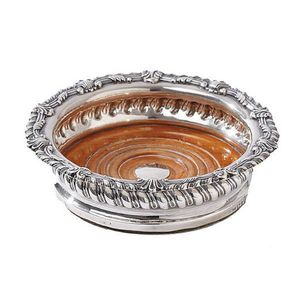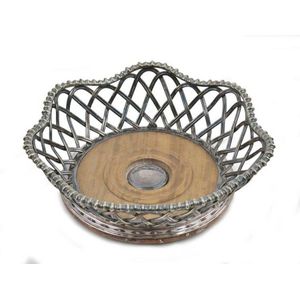Sheffield Plate Bottle Coaster, 1853
You must be a subscriber, and be logged in to view price and dealer details.
Subscribe Now to view actual auction price for this item
When you subscribe, you have the option of setting the currency in which to display prices to $Au, $US, $NZ or Stg.
- Sheffield Plate - Sheffield plate was the first commercially viable method of plating metal with silver. The method of plating was invented by Thomas Boulsover, a Sheffield Cutler, in 1743 and involved sandwiching an ingot of copper between two plates of silver, tightly binding it with wire, heating it in a furnace and then milling it out in to sheet, from which objects could be made.
Originally used by its inventor to make buttons, the potential of the material was quickly realised, and soon it was being used to fashion boxes, salvers and jugs, and not long after that candlesticks and coffee pots, and other traditional tableware.
Although there was a considerable saving in the amount of silver used, Old Sheffield Plate manufacture was more labour intensive than solid silver, meaning higher labour costs. This meant that Old Sheffield Plate was very much a luxury product, and only available to the very wealthy.
The thickness of the silver means that many 18th century Sheffield Plate pieces still have a good layer of silver, while electroplated pieces (EPNS), may have been replated several times over their lifetime. Where the silver has worn off the Sheffield plate the soft glow of the copper base can be seen underneath. However this is not an infallible guide that the piece is Sheffield Plate, as many EPNS items were also plated on to a copper base.
Most Sheffield plate items are unmarked, whereas most elecroplated items display manufacturers names or marks, quality indications such as "A1", "EP", together with pattern or model numbers.
Sheffield plate was made commercially between 1750 and 1850. - Circa - A Latin term meaning 'about', often used in the antique trade to give an approximate date for the piece, usually considered to be five years on either side of the circa year. Thus, circa 1900 means the piece was made about 1900, probably between 1895 and 1905. The expression is sometimes abbreviated to c.1900.
This item has been included into following indexes:
- Elkington & Co. (England)
- Sheffield plate - other items 378
- wine coasters and bottle stands - silver plate items 201
Visually similar items

A George III silver wine coaster by S.C.Younger & Co., Sheffield 1813, with shell capped and ribbon moulded gadrooned rim and embossed body, the turned interior with silver plug, 16 cm width.

Two sterling silver pierced bowls, hallmarked Birmingham 1910, monogrammed to centre, 64 grams

Abelam yam mask, woven figure and natural earth pigments. Used in the yam ceremony to promote the fertility of the crop. East Sepik Province,Papua New Guinea, W. 34 cm

A George III sterling silver circular salver with pierced border and contemporary crest and floral cartouche by Abraham Portal, London 1762. 34 cm diameter, 1240 grams
